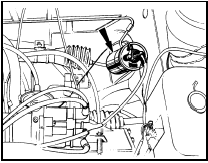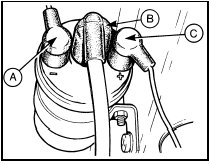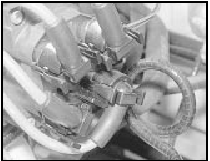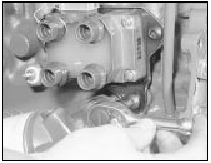Ignition HT coil - testing, removal and refitting
Note: Refer to the precautions given in Section 1 before proceeding.
All except models with DIS
ignition system
Testing
1 Accurate checking of the coil output
requires the use of special test equipment and
should be left to a dealer or suitably equipped
automotive electrician. It is however possible
to check the primary and secondary winding
resistance using an ohmmeter as follows.
2 To check the primary resistance disconnect the LT and HT wiring at the coil and connect the ohmmeter across the coil positive and negative terminals (see illustrations). The resistance should be as given in the Specifications at the beginning of this Chapter.

4.2a Ignition coil location (arrowed) - CVH engines with contact breaker
ignition system

4.2b Ignition coil terminal identification - contact breaker ignition system
A Negative LT terminal to distributor B HT terminal to distributor cap C Positive LT feed terminal
3 To check the secondary resistance, connect one lead from the ohmmeter to the coil negative terminal, and the other lead to the centre HT terminal. Again the resistance should be as given in the Specifications.
4 If any of the measured valves vary significantly from the figures given in the Specifications, the coil should be renewed.
5 If a new coil is to be fitted, ensure that it is of the correct low voltage type suitable for use in conventional ignition systems equipped with ballast resistance.
Removal
6 The ignition coil is mounted on the engine
compartment right-hand inner valance on
OHV engine models, and on the left-hand
inner valance on CVH engine versions.
7 To remove the coil, disconnect the LT leads at the coil positive and negative terminals and the HT lead at the centre terminal.
8 Undo the mounting bracket retaining bolts and remove the coil.
Refitting
9 Refitting is the reverse sequence to removal.
DIS ignition system
Testing
10 Testing of the DIS type ignition coil
requires the use of specialist equipment, and
should be entrusted to a Ford dealer.
Removal
11 On 1.1 and 1.3 litre HCS engines, the coil
is mounted on the cylinder block, above the
oil filter.
12 On 1.6 litre Electronic Fuel Injection (EFI) engines, the coil is mounted on the left-hand side of the cylinder head (see illustration).

4.12 DIS coil location (plastic cover removed) - 1.6 litre Electronic Fuel
Injection engine
13 Disconnect the battery negative lead.
14 If applicable, remove the securing screw(s) and withdraw the plastic cover from the coil.
15 Release the retaining clip, and disconnect the coil wiring plug.
16 Compress the retaining clips on each side of the HT lead connectors, and disconnect the HT leads from the coil. Note the location of each lead to ensure correct refitting.
17 Remove the securing screws, and withdraw the coil (see illustration).

4.17 Removing a DIS coil securing screw - 1.3 litre HCS engine
Refitting 18 Refitting is a reversal of removal, ensuring that the HT leads are correctly reconnected.
See also:
Key to wiring diagrams
Key to wiring diagrams
Key to wiring diagrams ...
Ignition system component check (Every 24 000 miles (40 000 km) or 2 years)
1 Before disturbing any part of the ignition
system, disconnect the battery negative lead.
2 Identify and clearly mark all HT leads before
disconnecting them from the spark plugs.
3 Refer to the a ...
Engine oil and filter renewal (Every 6000 miles or 6 months)
1 Frequent oil and filter changes are the most
important preventative maintenance
procedures that can be undertaken by the DIY
owner. As engine oil ages, it becomes diluted
and contaminated, which ...
